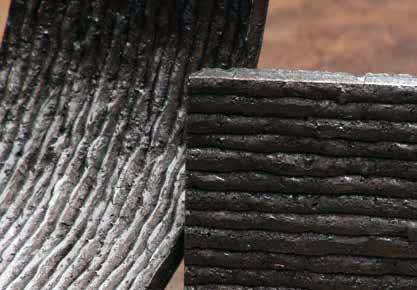
HARDLITE™ THIN CHROMIUM CARBIDE PLATE
HARDLITE™
Hardlite chromium carbide overlay extends the range of overlay plate available from St. Lawrence. Designed for applications with thickness or weight limitations that can not be met by our thicker Utra-Met.
Hardlite ultra-thin chromium carbide plate is available in thicknesses of 5/32″, 13/64″ or 1/4″ nominal. The performance of Hardlite wear plate has been proven to provide exceptional wear protection in many of the harshest environments.

AVAILABLE STOCK SIZES (48″ X 96″ PLATES)
| Layers | Nominal Thickness | Base | Hardfacing |
|---|---|---|---|
| Single | 5/32″ (4mm) | 5/64″ | 5/64″ |
| Single | 16/64″ (5mm) | 5/64″ | 1/8″ |
| Single | 1/4″ (6mm) | 1/8″ | 1/8″ |
ADVANTAGES
- Optimum hardness of 66-68 RC
- Adaptable, lighter, harder
- High wear resistance and moderate impact protection
- Wear resistant up to approximately 400°F
- Made in U.S.A.
- Adapted for applications where weight & clearance is restricted
- Maximum Sliding Abrasion Resistance
- Available in multiple thicknesses

CHEMISTRY (TYPICAL %)
| Cr | C | Ni | Mn |
|---|---|---|---|
| 23 - 35% | 3.5 - 4.5% | 0.2%* | 1.0%* |
STEEL PLATE COMPARISON
| Product | Abrasion Resistance | Impact Resistance | Weldability | Machinability | Forming | Cutting |
|---|---|---|---|---|---|---|
| MAN-CRO 400F | G | VG | VG | F | G | VG |
| MAN-CRO 450F | G - VG | G | G | M - F | F - G | G - VG |
| MAN-CRO 500F | VG | F | F | M | F | G |
| AR-Max | VG | VG | VG | F | G | VG |
| Ultra-Met Standard | E | G | E(1) | M(2) | F | G(4) |
| Ultra-Met Impact | VG | G - VG | E(1) | M(2) | M - F | G(4) |
| Ultra-Met Abrasion | E - S | G | E(1) | M(2) | F | G(4) |
| Hardlite | E | G | E(1) | M(2) | F | G(4) |
| SLS 14% Manganese | F | E | VG(3) | M | G | G |
S: Superior, E: Excellent, VG: Very Good, G: Good, F: Fair, M: Marginal
(1) Carbon Base Only
(2) EDM, Plasma or Air Arc holes only
(3) When welding Manganese to any other metal, use 309 or 310 SS electrode w/ minimum heat input
(4) Plasma, waterjet or laser
FABRICATION
We recommend the use of St. Lawrence’s fabrication services to eliminate processing and fabrication errors.
WELDING
Welding of Hardlite can be accomplished by joining of the carbon steel base material using a low hydrogen welding rod or wire. No preheating is required. When welding two pieces of Hardlite, bevel base plate (underside) and complete using normal welding procedure. Can be field pierced with covered metal electrodes; Chamfer-Trode, Rocket Groove, Cut-Trode or equivalents.
CUTTING
Hardlite can be cut with water jet, plasma burning equipment, air arc or abrasive saws. The minimum recommended plate temperature should be +60°F during processing.
GOUGING (CARBON ARC)
A conventional constant current DC welding supply 80V is recommended for gouging. Gouging should occur from the base metal side of the Hardlite plate. Remove slag with a grinding disc.
SAWING
Although a slower process, cutting can be achieved using an abrasive silicon carbide wheel.
FORMING
Hardlite can be formed to a radius of not less than 20 times the thickness using press brakes or rolls. If using rolls it is recommended that a 10 ga. sheet of mild steel be placed on top of the Hardlite to prevent nicking of the surface of the forming rolls. It is recommended that plates be rolled in the direction of the overlay weld beads. Forming will either increase or decrease the width of the stress relief cracks in the overlay. This result should be expected and should not adversely affect the performance of the Hardlite fabrication if the radius recommendations are followed.
MACHINING
Shearing, punching or machining is not recommended. Hardlite can be efficiently blanchard ground. A magnetic table will hold base metal, but Hardlite is non-magnetic, so if base is to be ground, also, use mechanical means to hold the plate.
REPAIRING
To repair the surface of Hardlite, use a manual arc welding process, St. Lawrence PN 200-W-ACF hard surface wire is recommended. Additional cracks may be noticeable, but will not affect abrasion resistance.
GRINDING
Hardlite can be abrasive ground with a hard grit, soft bond stone.
MECHANICAL PROPERTIES (TYPICAL)
| Layers | Surface Hardness | ASTM G-65 Mass Loss |
|---|---|---|
| Single | 66 Rc | .164 g |

